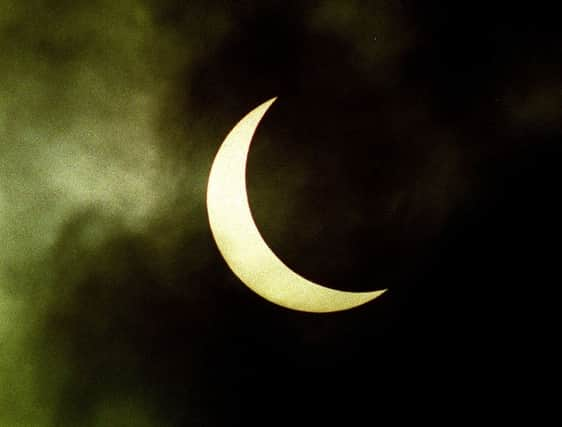Notts: How to safely view Friday’s solar eclipse


The most important message is never to look directly at the Sun, even through sunglasses or dark material such as a bin liner or photographic negative.
Makeshift filters may not screen out the harmful infrared radiation that can burn the retina of the eye.
Advertisement
Hide AdAdvertisement
Hide AdHere are some of the best safe methods of observing the magical moment when the Moon moves in front of the Sun.
*Use a mirror: Cover a small flat mirror with paper that has a small hole cut in it. The hole does not have to be circular but should be no wider than 5mm. A larger hole will produce a brighter but fuzzier image.
Prop up or clamp the mirror so that it reflects the sunlight onto a pale screen or wall, ideally through a window. A projection distance of five metres (16.4 feet) will produce an image of the Sun just over 5cm across.
The eclipse can be seen in the image as the Moon starts to take a “bite” out of the Sun, appearing upside down compared with its position in the sky.
Advertisement
Hide AdAdvertisement
Hide AdIf clouds move across the face of the Sun, they can be seen as well.
The smaller the mirror and further away the wall, the sharper the image will be. Experiment with the distances and mirror size.
Do not look into the mirror during the eclipse as this is just as dangerous as looking directly at the Sun.
*Eclipse viewing glasses: These are the only way of viewing the eclipse directly, other than through a telescope fitted with a professional filter. Similar to 3D glasses, eclipse viewers are made from card and inlaid with a special material that cuts the Sun’s light down 100,000 times. If using a viewer, check for holes or scratches as it is only safe if undamaged.
Advertisement
Hide AdAdvertisement
Hide AdEclipse viewers are being given away free with the Society for Popular Astronomy’s members’ magazine and the BBC’s Sky at Night magazine.
*Projection from binoculars or a telescope: Cover one eyepiece of a pair of binoculars with a lens cap and face the “big” end of the binoculars towards the Sun. The uncovered lens will project an image of the Sun that can be cast onto a plain card held about a foot away. Use the focus wheel to sharpen the image.
Ideally, the binoculars should be fastened to a tripod or stand. A cardboard “collar” with holes cut to fit the large lenses will shade the card on which the image is projected.
HOW TO PHOTOGRAPH THE ECLIPSE:
Photographing an eclipse is fun and easy - but you will need to use a proper solar filter to do it safely.
Advertisement
Hide AdAdvertisement
Hide AdAlmost any kind of camera can be used to capture the event, but your phone will not have a proper solar filter.
A lens with a fairly long focal length would be ideal. A standard 50mm lens on a 35mm film camera yields a tiny 0.5mm image, while a 200mm telephoto or zoom produces a 1.9mm image.
With point and shoot cameras, those with wide angle lenses are perfect for capturing the quickly changing light in the seconds before and during totality.
Alternatively, use a straw hat, sieve or colander and allow its shadow to fall on a piece of white cardboard several feet away. The small holes act like pinhole cameras, and each one projects its own image of the eclipsed sun. Virtually any camera can be used to photograph the phenomenon, but automatic cameras must have their flashes turned off because this would otherwise obliterate the pinhole images.